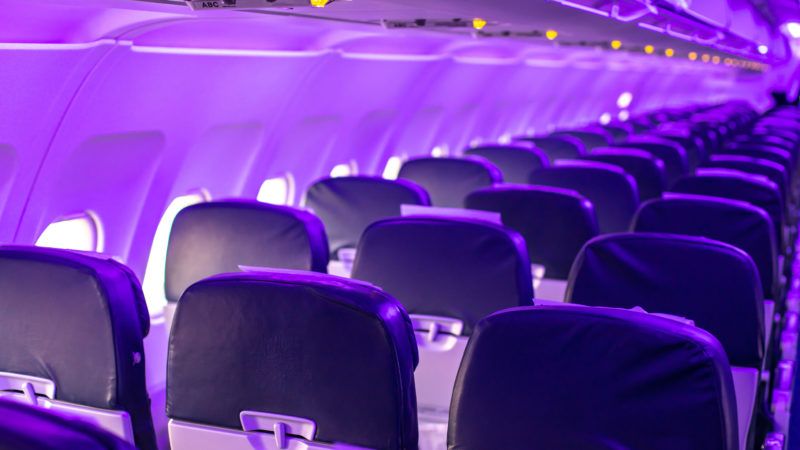The Federal Government Is Spending $60 Billion To Keep Mostly Empty Commercial Planes Flying Over the U.S.
Pending minimum service rules would require airlines to keep operating a certain number of flights, regardless of how little demand there is for air travel.

It's no secret that the coronavirus pandemic has been particularly devastating for the airline industry, with the number of passengers paying to fly falling by as much as 95 percent compared to this time last year.
Air carriers' financial pain proved enough of a justification for Congress to include $60 billion in financial assistance to the industry as part of the $2.3 trillion economic relief package it passed last week.
This aid isn't without strings, however. Airlines are being asked to maintain a minimum level of service to qualify for emergency government funding. The result has been companies running nearly-empty, money-losing flights just so they can avail themselves of taxpayer support.
When Congress passed the Coronavirus Aid, Relief, and Economic Security (CARES) Act, it included $50 billion evenly divided into loans and grants for passenger air carriers. The law also empowered the Secretary of Transportation to require airlines to continue flying to locations they were servicing before March 1, 2020.
On Tuesday, the U.S. Department of Transportation (DOT) issued proposed guidance that specifies the minimum levels of service passenger airlines have to maintain to qualify for CARES Act assistance.
If an airline flew into a city at least five times a week prior to March 1, it will have to continue to offer at least five flights a week to the same city. If an airline flew into a city less than five times a week, it will have to offer only one flight per week.
This guidance allows the biggest air carriers, who flew lots of flights into lots of cities, to substantially reduce their service levels. "You can literally go from that 25 or 30 flights a day to Albuquerque down to one," one airline industry consultant told NPR.
Low-cost budget carriers who offered fewer flights are required to maintain a higher percentage of their existing service. For that reason, these low-cost carriers have been some of the biggest critics of the new DOT guidance.
Frontier Airlines, in a public comment on the new guidance, noted that it flew a total of five flights a week into four airports prior to March 1. That means the proposed DOT rules will require it to maintain 100 percent of its service at those locations. In another 10 cities, said Frontier, the DOT rules only allow it to reduce service by less than 50 percent, despite demand dropping off by more than 90 percent.
DOT's "minimum service requirement bears no realistic relationship to current reduced passenger demand," wrote the airline, adding that the order "amounts to a government edict to operate more flights with the attendant costs and burdens regardless of whether those flights are empty or have load factors in the single digits or teens. That does not make sense."
The National Air Carrier Association (NACA), a trade association representing budget carriers, argues that the new rules also do not take into account the seasonality of many low-cost airlines' services.
"By not taking into account the seasonality of air service provided by a large number of air carriers," wrote NACA, DOT's proposed minimum service requirements "would require carriers to maintain a schedule developed for the peak winter travel season into the spring travel season and beyond."
"As a result, a significant number of carriers would be placed at a competitive disadvantage vis-à-vis U.S. legacy air carriers" whose service is less affected by seasonal peaks and troughs, wrote NACA.
The proposed DOT guidelines would allow airlines to apply for exemptions, but approving those could take time, and there's no guarantee that every carrier that wants one would receive one.
NACA and the budget carriers they represent are asking that lower minimum service requirements be incorporated into any final rule.
A DOT spokesperson tells Reason that comments on the department's proposed rules are still being considered, so there's still a possibility that the budget airlines will get their proposed changes included in the final rule.
At the same time, however, members of Congress, as well as smaller regional airports, are demanding that airlines be required to maintain service at each airport they regularly fly into, not just each city. That request, if adopted by DOT, would have the effect of increasing the minimum number of flights airlines would have to fly.
While DOT hashes out a final rule, NPR reports that the U.S. Treasury Department is encouraging airlines to apply for financial aid by today, otherwise it could get delayed. The confusion over conditions for receiving financial assistance, reported The Air Current on Tuesday, is causing airlines to backtrack planned reductions in service.
The result, as countless news articles have pointed out, is airlines running ghost flights that have more airline staff than paying customers on them.
Burning cash to get that bailout cash. https://t.co/9nf7IPgISS
— Justin Amash (@justinamash) April 1, 2020
We are left in the worst possible world of businesses getting a bunch of taxpayer money on the condition that they waste it. This is central planning at its most illogical, and it's making all of us poorer.
Rent Free is a weekly newsletter from Christian Britschgi on urbanism and the fight for less regulation, more housing, more property rights, and more freedom in America's cities.


Show Comments (47)